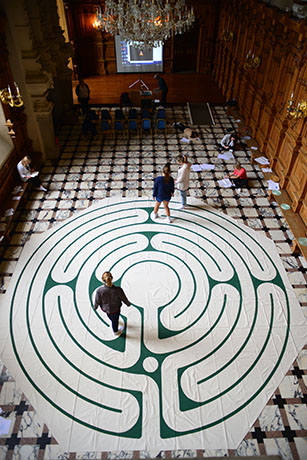Labyrinths in Places
Labyrinths are found in many places. Some are permanent and some are brought in temporarily for events. The challenge for labyrinth enthusiasts is often how to get permission to introduce a labyrinth into a specific environment. This section of the website examines some of the places where labyrinths may be found, the benefits of having them there, how they are used, and how people were able to install them there in the first place!
1. Introduction
This section of 'Labyrinths in Use' presents the creation and use of labyrinths in Higher Education. Written from an international perspective, it includes labyrinths in North America, Asia, Australasia, and Europe.
As the primary author of this section is British, please note that the word staff is used in the British sense, inclusive of faculty and other colleagues.

The labyrinth is a powerful and beautiful resource that can become wellsprings of quietness and peace in our universities and colleges, and for the wider community. The growing interest in labyrinths in academic contexts shows no sign of abating: we invite you to explore these pages, to share your own ideas and - not least - to record and write about your findings and experiences. This field is under-researched and the possibilities are wide-ranging. For more on this, see the closing webpage in this section, and The Labyrinth Society's call for researchers on this website.
If you are looking for a particular university labyrinth, or any labyrinths associated with universities, please visit the World Wide Labyrinth Locator. You can filter your search by using the key words 'university' or 'college', though some of these are churches or medical centres associated with, or near, a university. For a broader search, use the filter for 'School or Educational Centre'.
Photo by Katie Carlson, Harlaxton College
Arts, Health and Wellbeing workshop, Marian University Summer School, Harlaxton College, England
Prepared for the Labyrinth Society by Jan Sellers, lead editor of Learning with the Labyrinth: Creating reflective space in higher education (Sellers and Moss, 2016). Web pages revised 2018 by Jan Sellers, Jodi Lorimer, and Diane Rudebock. We will be glad to hear from you: please visit the Research area of the TLS website or Jan Sellers' website.
